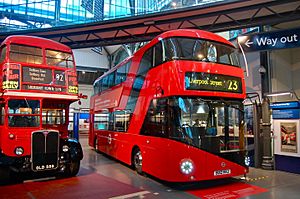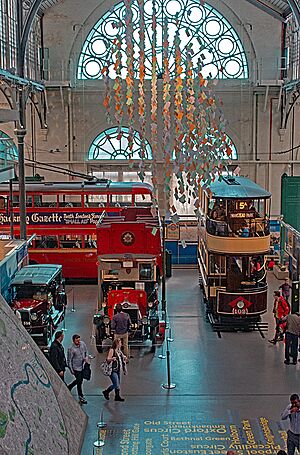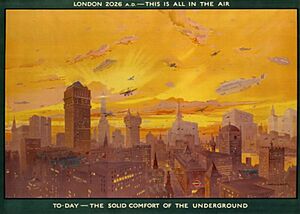London Transport Museum facts for kids
 |
|
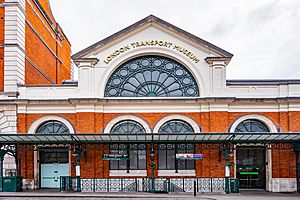
Exterior of the London Transport Museum in 2018
|
|
| Lua error in Module:Location_map at line 420: attempt to index field 'wikibase' (a nil value). | |
| Established | 1980 |
|---|---|
| Location | Covent Garden London, WC2 |
| Type | Transport museum |
| Visitors | 411,766 (2019) |
| Owner | Transport for London |
| Public transit access | |
The London Transport Museum (LTM) is a cool place in Covent Garden, London. It's all about the history of transport in London. Imagine seeing old buses, trains, and even horse-drawn carriages! The museum collects and shares stories about how people have moved around the city for hundreds of years.
Most of the items in the museum used to belong to London Transport. But now, the museum covers all kinds of transport in London. This includes everything managed by Transport for London (TfL), which is the main transport group in the city.
The museum has two main spots in London. The main one is in Covent Garden. It's open almost every day. It had a big makeover and reopened in 2007. The other spot is called the London Transport Museum Depot. It's in Acton and is mostly for storing old vehicles and items. You can visit the Depot on special days throughout the year.
The museum also offers special tours called "Hidden London." These tours take you to secret parts of the London Underground that are usually closed. You can explore old, unused stations and even wartime shelters!
The museum's name was briefly "London's Transport Museum." This was to show it covered more than just London Transport. But in 2007, it went back to its original name. This happened when the Covent Garden museum reopened.
Last year, in July 2024, the museum got a new look for its brand. This new look shows that it covers all of London's transport. It's not just about buses and trains anymore. The new logo uses all the colours of TfL's different transport types.
Contents
The Main Museum in Covent Garden
The main museum building is really interesting. It's a Victorian building made of iron and glass. It used to be a flower market! William Rogers designed it in 1871. The market moved out in 1971. Then, the building became the London Transport Museum on March 28, 1980.
Before Covent Garden, the museum's collection was at Syon Park from 1973. Even before that, it was part of the British Transport Museum in Clapham.
In 2005, the museum closed for a big update. It cost £22 million! The goal was to make more space for all the new transport items. They also wanted better places for learning. The museum reopened on November 22, 2007.
You can find the museum entrance from the Covent Garden Piazza. It's easy to walk there from Covent Garden Underground station. It's also close to Charing Cross railway station.
What's in the Collection?
The museum started collecting things a long time ago. In the early 1900s, the London General Omnibus Company (LGOC) began saving old buses. When the London Electric Railway (LER) took over LGOC, they started collecting trains too.
The collection kept growing. It grew even more when the LER became part of the London Passenger Transport Board in the 1930s. It continued to expand as different transport groups took over. Now, Transport for London (TfL) is in charge.
The collection has been in a few different places. From 1963 to 1972, it was in a disused tram depot in Clapham. Then, from 1973 to 1977, it was at Syon Park in Brentford. Finally, it moved to Covent Garden in 1980. Many other items from the collection went to York in 1975. They became part of the National Railway Museum.
At the Covent Garden museum, you can see many old buses, trams, trolleybuses, and trains. These are from the 1800s and 1900s. You'll also find items about how transport services worked. You can learn how the growing transport network changed London and its people. The very first underground electric train, from 1890, is here!
Bigger items are kept at the Acton depot. These include a full 1938 stock tube train. There are also early locomotives from the first underground lines.
Hidden London Tours
In 2015, the museum started its "Hidden London" tours. The museum had actually been doing tours of unused stations since the 1990s. There were also special one-off events in the 2010s.
These tours let you see parts of the London Underground that are usually closed. They tell the story of London through its underground system. The tours are based on amazing findings from the museum's huge collection of old records.
You can explore places like the unused Aldwych and Down Street stations. You can also see secret areas of Piccadilly Circus, Charing Cross, and Euston stations. There's even a wartime deep level shelter in Clapham South.
In 2023, a tour of Baker Street underground station was added. This celebrated the 160th birthday of the London Underground. Last year, in 2024, the museum launched a new tour called "Holborn: The Secret Platforms."
A new tour, "Dover Street: Alight here for Green Park," will start in January 2025.
There are also online virtual tours you can take. Plus, there's a walking tour around the museum area.
The money made from Hidden London tours helps the museum. It supports their work as a charity for education and heritage.
Other Fun Things to Do
The museum has some cool simulator experiences. You can try an Elizabeth Line simulator with a train cab. There's also a smaller standing version. Plus, you can try a 1938 stock simulator. It even has a special "deadman's handle" like real trains!
An exhibition about Hidden London ran until July 2023. It had a smaller, walk-through copy of the Aldwych Ticket Hall. It also showed the Down Street Blitz Shelter. This shelter was used by Winston Churchill during World War II. The exhibition shared stories of London's hidden transport places.
There's a special area for children to play. It has an Optare bus. There's also an "All Aboard" play-zone for kids aged 0-7.
Museum Shop
The museum shop is a great place to find gifts. It sells books, cool posters, models, and souvenirs. You can visit the shop at Covent Garden or buy things online. The money from sales helps the museum keep doing its important work.
Museum Depot in Acton
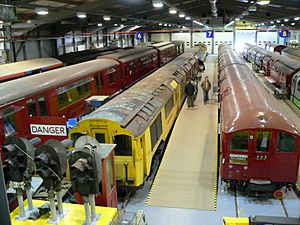
The Museum Depot is in Acton, west London. It opened in October 1999. This is where most of the museum's collection is kept. These are items not on display at the main museum in Covent Garden. It's also where the museum's experts work. They look after and fix the old items. It's also used to show items that are too big for the main museum.
The depot has a huge storage space, about 6,000 square metres. It keeps over 370,000 items safe. These include original artworks for posters, signs, models, photos, drawings, and uniforms. The building can be reached by road. It also has a rail connection to the London Underground network. This means they can store and show many buses, trams, trolleybuses, and trains.
The depot isn't open to the public all the time. But it's set up for visitors. It has a ticket office, a shop, and even a miniature railway. It opens for pre-booked tours several times a month. It also has special open weekends, usually three times a year. You can easily walk there from Acton Town Underground station.
How to Get There
| London Buses | Aldwych 11, 15, 26, 76, 172 Aldwych 243, 341 |
| London Underground | Covent Garden Leicester Square |
| National Rail | Charing Cross |
Images for kids
See Also
- List of British heritage and private railways
- List of transport museums (around the world)
- Other transport museums with items from London Transport
- London Bus Museum, Brooklands
- Alderney Railway – on the Island of Alderney
- East Anglia Transport Museum – near Lowestoft
- National Railway Museum – York
- National Tramway Museum – Crich
- The Trolleybus Museum at Sandtoft – in North Lincolnshire
- Other transport and industrial museums in London
- Other major transport museums in the UK
- Black Country Living Museum
- Brooklands Museum
- Riverside Museum, Glasgow
- Museum of Transport in Manchester
- Ulster Folk and Transport Museum
- Coventry Transport Museum
- Museum of the Great Western Railway, Swindon
- National Motor Museum, Beaulieu, Hampshire
- Past transport museums in the UK


